How to Grow Strawberries
Preview: You can grow strawberries in your backyard. This post shares all the details of how to grow strawberries at home.
How to Plant Strawberries
Strawberries are typically planted in early spring but they can be planted in the fall in zones 7 and higher. While they can be started from seed, most people prefer starting with plants, also called crowns. Strawberry plants usually come in pots or as bare-root plants.
Strawberry plants are perennials, meaning they will come back every year. So choose your location carefully for your strawberry beds. However, after 3 to 4 years, the plants slow production so it is recommended to replace the plants every few years.
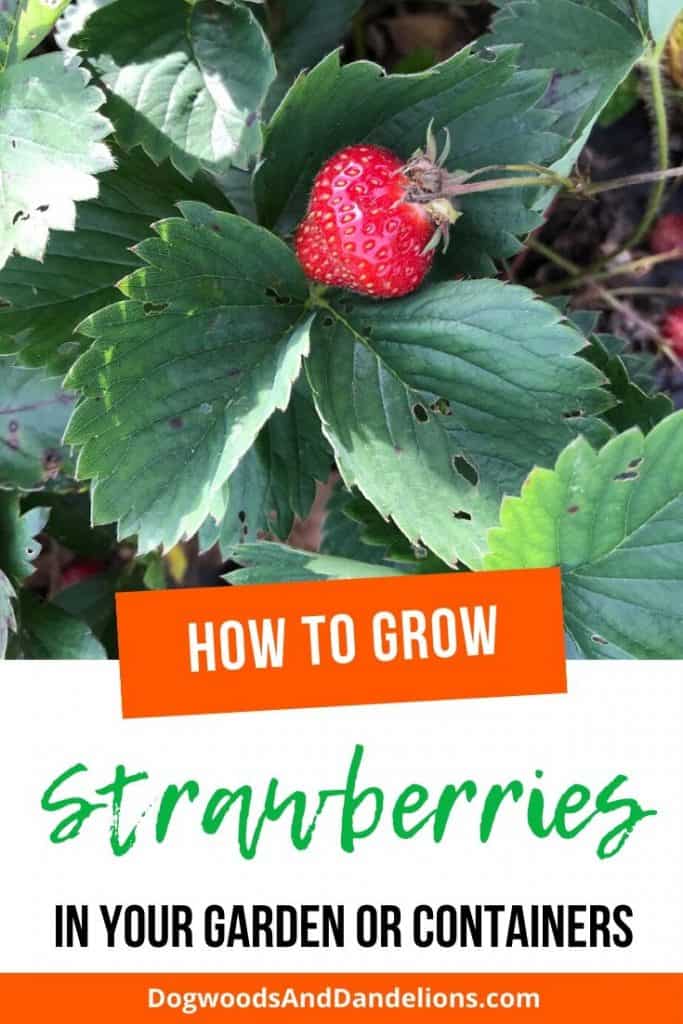
Affiliate Disclosure: Please note that some of the links in this article may be affiliate links and I may receive a small commission if you purchase something through a link. It will not change your cost. As an Amazon Associate, I earn from qualifying purchases. For more information, see my disclosures page.)
Strawberries need at least 8 hours of direct sunlight each day, so be sure to locate a sunny spot before planting your new plants. Plant strawberries 18″ apart. They grow best in slightly acidic, well-drained soil (pH of 5.5 to 6.8). (If you need to find out your soil pH, this post explains how to do a soil test.)
When planting strawberries, mix in some compost or other organic matter to improve the soil. This is especially helpful if you have heavy clay soil (like I do)!
If you are planting bare-root strawberry crowns, soak them in water for an hour. Spread the roots out before planting.
It is very important to plant the strawberry crowns properly. Planting the crown of the plant too deep will cause the plant to rot. Too shallow and they will dry out. The diagram below should guide you to the proper planting depth for strawberries.
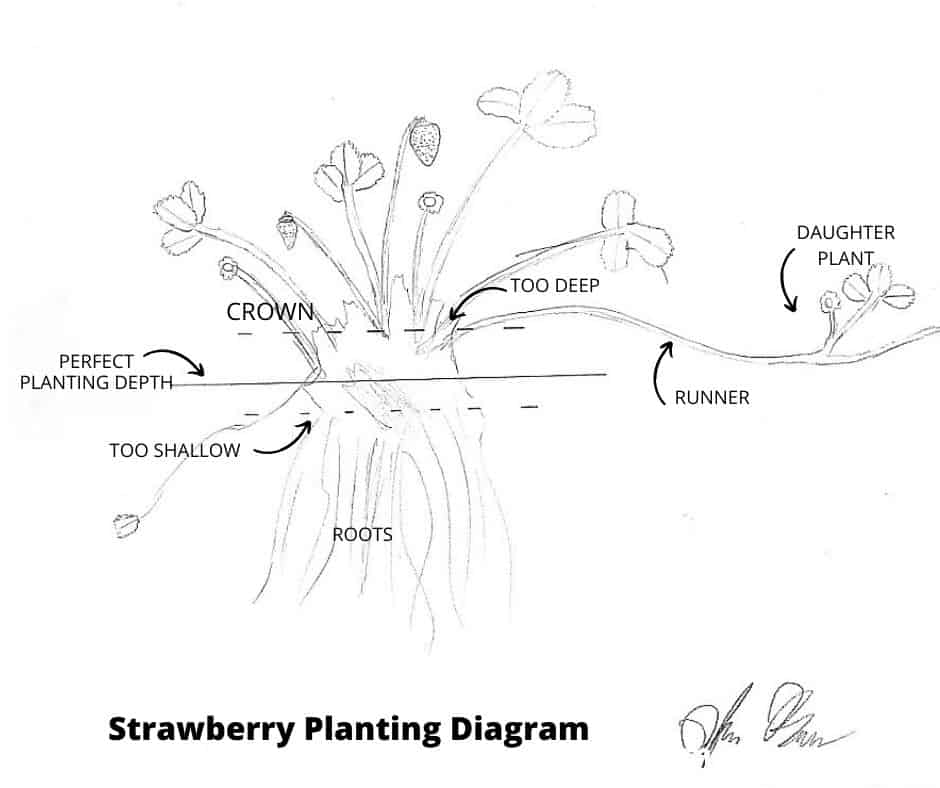
Drawing by my eldest son.
Dealing with Runners
Strawberry plants send out runners, basically small “daughter” strawberry plants. While you may be thinking “Yay! Free strawberry plants” these baby plants are taking energy from the mother plants instead of producing strawberries.
Most experts advise clipping the runners as soon as you notice them. However, you can leave a few or clip them and replant them somewhere else if you can’t bear to throw them out.
Keep in mind that they do need to have roots or there is no point in replanting the daughter plants. I recommend clipping all runners in the first year. The following year, you can leave a few to replace any plants that died.
Keeping the Strawberries Clean
Keeping strawberries clean can be a daunting task. Since most berries grow near the ground, dirt splashes on them when it rains. The best way to prevent dirty strawberries is to use some type of mulch.
Straw, pine needles, pine bark mulch, and dead leaves all make good mulch. You can also use black plastic around your strawberry plants to keep the berries clean. You’ll notice many commercial growers use the plastic.
I recently discovered these strawberry cradles to keep the strawberries clean. While I haven’t tried them myself, they do look promising. I also think they might help keep the slugs (see below) from eating your berries.

Do I Really Have to Remove Strawberry Flowers the First Year?
When you start reading about how to grow strawberries, many experts will recommend removing all the flower buds in the first growing season. Yes, this probably makes the strawberry plants bigger and healthier in the following years.
But I am not going to tell you to do that. After all, who can wait a whole year for homegrown strawberries? Not me.
I do recommend cutting off all the runners the first year, but my strawberries have done just fine without ever cutting off the first-year blossoms. So if you feel you must cut them off, do so. But when I replant mine this year, I plan on eating every strawberry I find.
Watering & Fertilizing Strawberries
Your strawberries need about 1 to 1.5″ of water each week. If possible, try to avoid getting the leaves wet. Water at the roots. This is a great time to use a soaker hose.
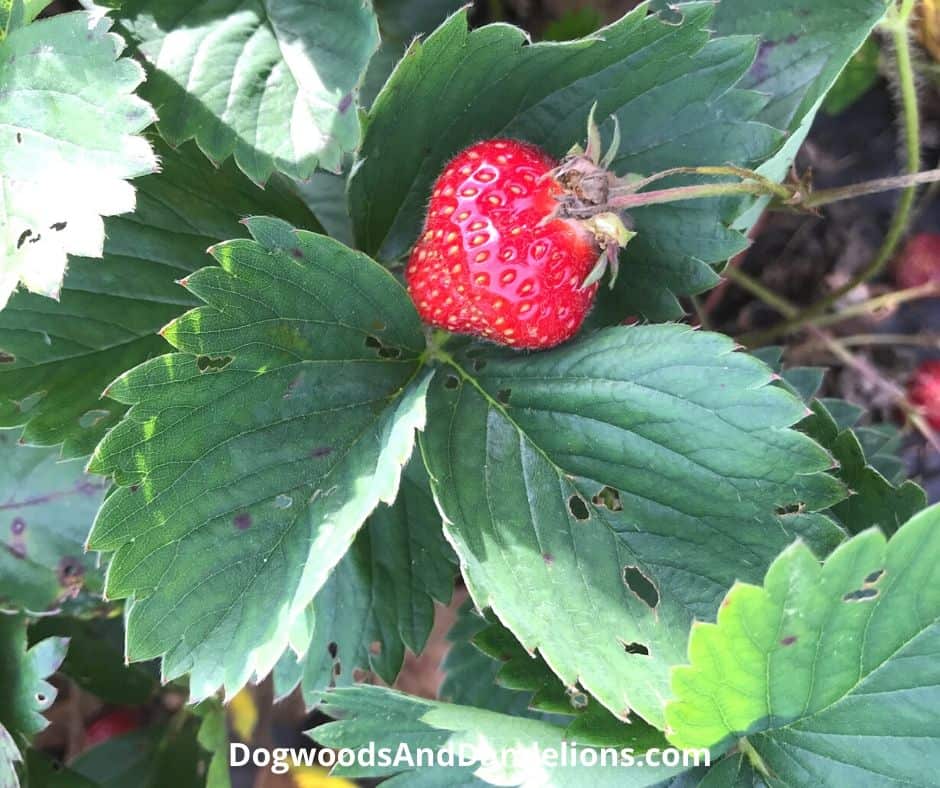
Fertilize strawberries using a 10-10-10 (nitrogen, phosphorus, potassium) organic continuous release fertilizer according to package instructions. You can also purchase an organic berry fertilizer if you choose.
If you are growing strawberries in containers and started with fresh potting soil that contains fertilizer already, it may not be necessary to fertilize the first few months. (Look at your potting soil to see if it contains fertilizer and if so, how long the fertilizer lasts.)
In the fall after the strawberries have stopped producing, cut the foliage back to an inch above the crown.
Strawberry plants die back in the winter in cold climates. Depending on how low your temperature dips, your plants may die back totally, or not much at all. Here in North Carolina (zone 7b) my plants usually don’t die back much.
If you live in zones 6 or below, I recommend adding a layer of mulch over your strawberry plants at the end of the season (late fall). Mulching with about 6 inches of straw will help to prevent the plants from heaving during periods of freezing and thawing temperatures. (Don’t know your gardening zone? Find it here.)
When it starts to warm up in the spring, remove the mulch. Once the plants start growing, you can reuse the same mulch around the berry plants to keep the soil moist and the fruit clean.
How to Grow Strawberries in Containers
Strawberries also grow great in containers. And there are so many container options on the market now.
Be sure that whatever type of container you use has drainage holes in the bottom. If not, be sure you add some. Strawberry plants will rot if the soil is too wet.
The old fashioned strawberry planters are really cute and they work well. That’s why they have stood the test of time.
While the old ones were made from terra cotta and were heavy, there are updated types which I think will work well and be much lighter and easier to move.
For those on a budget, check out grow bags. These inexpensive containers are a great way to grow almost any vegetable or fruit.
The smaller grow bags are easily moveable and while they don’t have drainage holes, they are porous so they come ready to add soil and plant.
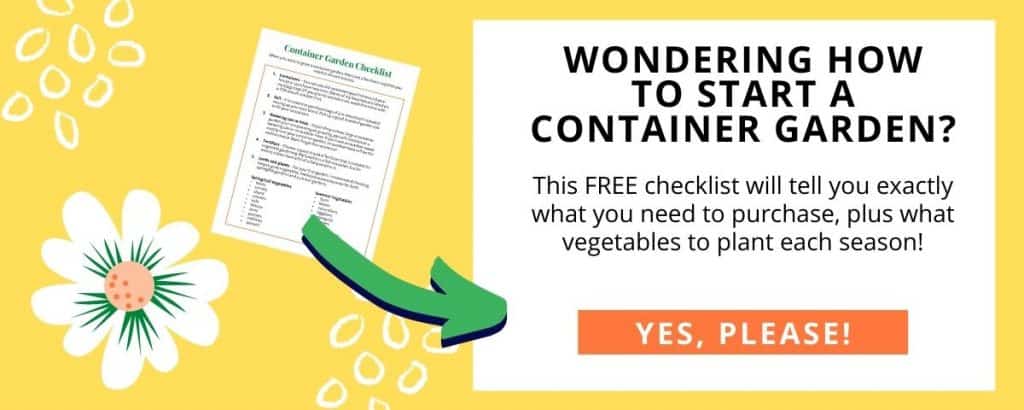
You can even plant strawberries in a hanging basket or a hanging grow bag on your porch. Just be sure they will receive adequate sunlight (8+ hours).
When planting strawberries in containers, be sure to use good-quality potting soil and plant them at the depth recommended above.
To over-winter your container-grown strawberries, place the container in an unheated garage during the winter. Check weekly to keep the soil moist, but not soggy.
3 Types of Strawberries
There are 3 main types of strawberries, Everbearing, June bearing types, and Day-Neutral varieties. Where you live and how often you want to harvest berries, will determine what type of strawberry is best for you to grow.
Everbearing strawberries produce a large crop in the spring, and then a few berries throughout the summer. Then, in the fall, they usually produce a second larger harvest.
June-bearing varieties of strawberries produce all their strawberries at once, usually over a 3-week period. While they are called June bearing, in warmer climates, they may actually start producing in late April. This type is best for those who want a large harvest all at once for preserving.
Finally, Day-neutral strawberries tend to produce continuously throughout the season. This is a good choice for cooler northern climates or small-space gardening. While still delicious, these strawberries usually produce smaller berries than the everbearing and june-bearing types.
How to Harvest Strawberries
Since strawberry plants are shallow-rooted, be gentle when picking. Cutting the berry from the plant with a pair of garden scissors is the best way to ensure you don’t pull the plants out of the ground.
Strawberries are ripe and ready to harvest when the berry has turned a deep red. Check your plants and harvest daily, as the berries don’t keep long on the plants.
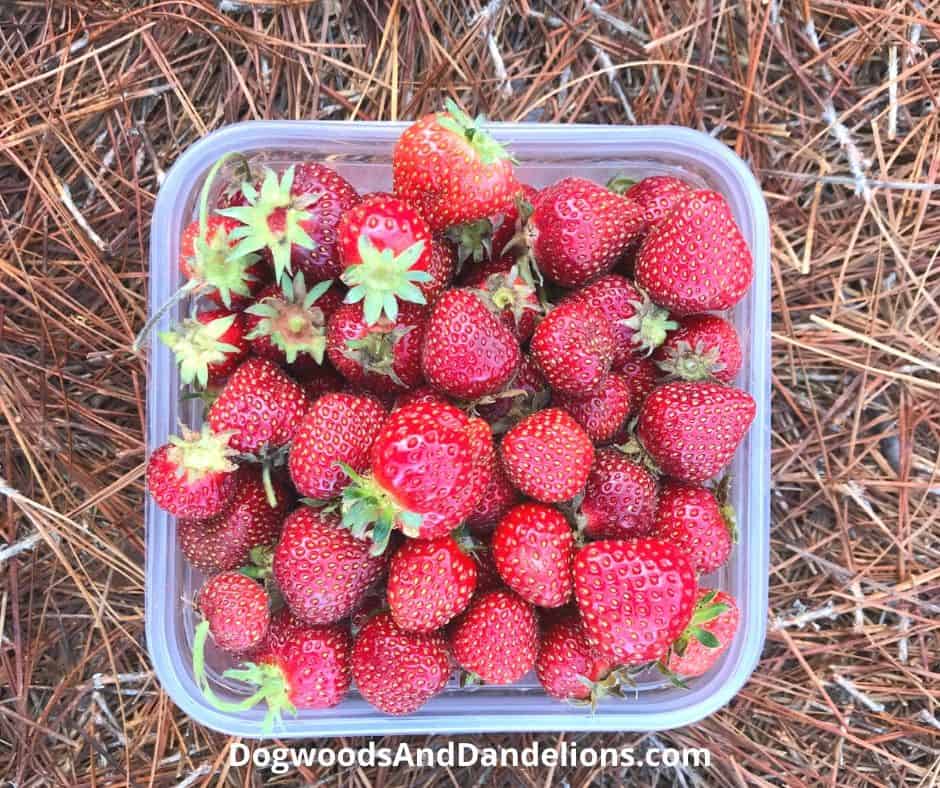
Most experts recommend picking strawberries first thing in the morning. The second best time is late in the evening.
HOWEVER, if you are going to eat the strawberries right then, I recommend picking them in the middle of the day when the sun has warmed them. Preferably, standing in the garden.
There is nothing better than eating a sun-warmed strawberry just plucked from the vine. You can’t buy that experience anywhere!
You can refrigerate the strawberries for up to 5 days after picking. But wait to wash your strawberries until just before eating or preparing.
Pests and Diseases of Strawberries
There are many, many pests that want to eat your delicious strawberries too. It’s probably why most store-bought strawberries are heavily sprayed with chemicals. Unfortunately, strawberries are also susceptible to many diseases.
Pests
Birds love to take a bite from your ripe berries. The easiest way to prevent them from damaging your crop is to place bird netting or row covers over the strawberry bed or container.
I’ve used the same package of bird netting for years over my strawberries and my blueberries and it has held up exceptionally well.
Slugs are another major pest in the garden. They can ruin a strawberry crop in a hurry.
There are several methods you can try to prevent the slugs. I have used all of these with varying degrees of success.
My first choice is to use crushed eggshells. Sprinkle them liberally around your strawberry plants. The eggshells cut into the slugs’ bodies so they don’t get to the strawberries.
Diatomaceous earth (DE) provides similar protection. Just be sure not to breathe it when applying around your berries. I recommend purchasing food-grade DE since you will be applying it around your food.
You can also try catching slugs by placing a shallow container of beer near the strawberries. They crawl in the beer and drown.
There are also many other winged insects that love to feed on strawberries such as spittlebugs, strawberry sap beetles, and tarnished plant bugs. I have successfully used neem oil as an organic method to keep many of these flying critters from devouring my strawberries.

Diseases
Strawberries can also fall to many fungal diseases like verticillium wilt and powdery mildew, and other diseases such as leaf scorch, leaf spot, and leaf blight.
This strawberry diagnostic key produced by the North Carolina Cooperative Extension Service is a great resource on strawberry diseases. This key will help you identify any diseases you may encounter while growing strawberries.
Deformed Berries
Deformed strawberries are usually the result of insufficient pollination. While bees aren’t necessary to pollinate strawberries, (Strawberries are pollinated by the wind.) the presence of bees and other insects will help ensure the berries get fully pollinated.
Best Varieties of Strawberries
Depending on where you live there are strawberry varieties that are best suited to your area. One of the best ways to find strawberries that will grow well in your area is to visit a local garden centers and purchase what they recommend. However, I listed below some of the more popular varieties that you might find locally or in catalogs.
For June-bearing strawberries, popular varieties include Allstar, Honeoye, Surecrop, Sparkle, and Earliglow.
Day Neutral types include Tristar, Seascape, and Quinalt.
Popular Everbearing strawberries are Fort Laramie, Ozark Beauty, and Tribute.
Recipes that use Strawberries
Now that you know how to grow strawberries, you need to know what to do with all those berries once the harvest starts rolling in. If you want to preserve some strawberries or use them in recipes, here are some ideas to get you started.
- This recipe for Strawberry Shortcake with Crunchy Drop Biscuits from An Oregon Cottage is so much better than the store-bought spongy cakes you can buy.
- A Greek Yogurt Strawberry Smoothie would be the perfect breakfast for me.
- This Frozen Strawberry Delight is the perfect make-ahead dessert for Easter or Mother’s Day when fresh strawberries are in season.
- I plan on making some Honey Sweetened Strawberry Jam this summer since strawberry is my favorite flavor.
Do you have a favorite strawberry recipe? If so, I would love it if you would share in the comments below.
Related Posts

